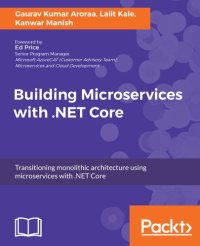
Ebook: Building Microservices with .NET Core
Author: Gaurav Kumar Aroraa, Lalit Kale, Kanwar Manish
- Tags: Computer Technology, Nonfiction, COM051310, COM051470, COM060180
- Year: 2017
- Publisher: Packt Publishing
- Language: English
- epub
Architect your .NET applications by breaking them into really small pieces—microservices—using this practical, example-based guide
About This Book
Who This Book Is For
This book is for .NET Core developers who want to learn and understand microservices architecture and implement it in their .NET Core applications. It's ideal for developers who are completely new to microservices or have just a theoretical understanding of this architectural approach and want to gain a practical perspective in order to better manage application complexity.
What You Will Learn
In Detail
Microservices is an architectural style that promotes the development of complex applications as a suite of small services based on business capabilities. This book will help you identify the appropriate service boundaries within the business. We'll start by looking at what microservices are, and what the main characteristics are.
Moving forward, you will be introduced to real-life application scenarios, and after assessing the current issues, we will begin the journey of transforming this application by splitting it into a suite of microservices.
You will identify the service boundaries, split the application into multiple microservices, and define the service contracts. You will find out how to configure, deploy, and monitor microservices, and configure scaling to allow the application to quickly adapt to increased demand in the future.
With an introduction to the reactive microservices, you strategically gain further value to keep your code base simple, focusing on what is more important rather than the messy asynchronous calls.
Style and approach
This guide serves as a stepping stone that helps .NET Core developers in their microservices architecture. This book provides just enough theory to understand the concepts and apply the examples.